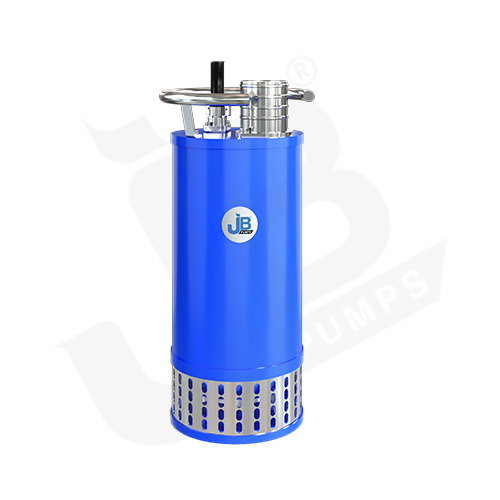JB Pumps manufactures a standard Submersible Dewatering Pumps which is used to extract or remove the water to make that place dry.
It is situated at the ground level to reduce the water level. Once the water is reduced it maintains the level. It is mostly used to reduce the water level at the building site, construction site, underground railways, bridges or in open-cast mining. Noise pollution through Submersible Dewatering Pumps is very less as it is present under the water. In this pump, cavitation is never an issue, because there is no “spike” in pressure as the water flows through the pump. Easy to use and maintain, JB Pumps promise optimal performance.
We are a leading manufacturer of the Submersible Dewatering Pumps which is quite reliable for the industrial application for removing the water from the deep inside. JB Pumps keeps a full range of pumps in all sizes available at all times. These pumps offer large solids handling capability whilst maintaining optimum pump hydraulic efficiencies. We develop the Submersible Dewatering Pumps are resistant to corrosion.

JBDPT Series
JBDPT series of dewatering pumps are specially designed for sea water, rain water and construction dewatering. The design of light weight, low maintenance. Vertical construction of pump, bottom suction and top discharge ensure to remove maximum water from pit.
LOOKING FOR THE BEST SOLUTIONS IN PUMPS MANUFACTURING?
What Are Submersible Dewatering Pumps?
Submersible dewatering pumps are centrifugal pumps used to pull water out from the bottom of the excavation area. Designed to move excess water from one location to another, it’s the best choice for construction sites, tunnels and mines, underground railways, bridges, and buildings to reduce and maintain the water level.
JB Pumps India Pvt. Ltd. is a leading submersible dewatering pump manufacturer in India. We design these pumps with unique built-in protections to overcome various operational challenges.
Our widest range of submersible dewatering pumps provides noiseless performance with superior resistance to corrosive liquids. With great pumping capacity, they can easily handle and remove liquid with abrasive and heavy solids.
What Are The Types Of Dewatering Systems?
Sump Pumping Dewatering System:
This is one of the most common and least complex methods for dewatering. It’s a cost-effective way for removing water with high content of sand or gravel from shallow excavation areas. When the water reaches a certain level, dewatering pumps get into action and start pumping the water away from the area.
Flood Control Dewatering:
The flood control method is used to reduce and prevent harmful flooding effects caused due to stormwater and heavy rainfall. Submersible dewatering pumps provide good flood protection by moving high volumes of water from construction, tunneling, or mine work sites and other low-lying areas.
Deep Wells Dewatering System:
The Deep Well method is highly suitable for deep excavation areas where large volumes of water need to be removed. The method involves boring deeper and wide wells containing submersible dewatering pumps used to lower the groundwater level below the excavation level.
Well Points Dewatering System:
In this method, a series of wells are drilled around the excavation area. Submersible dewatering pumps are installed in this well shaft, which are connected to the header piper and vacuum pump. The groundwater is pulled up by the pumps and discharges away from the site.
Bypass Dewatering System:
This technique is best suited for irrigation and construction projects when maintenance is required in sewer lines. Here submersible dewatering pumps are installed to pump sewage flow around the damaged pipe section.
Features Of Submersible Dewatering Pumps
- Resistant To Corrosion
- Wear Resistant
- Reliable & Economical
- Portable Design
- Excellent Solids Handling Capability
- Noiseless Operation
- No Pump Cavitation
- Easy To Use
- Low Maintenance
Advantages Of Submersible Dewatering Pumps
How To Do Dewatering At A Construction Site Using A Submersible Pump?
Dewatering construction sites is crucial for safer working conditions and building stable foundations. Choosing the most suitable dewatering pump and selecting the right dewatering method are critical steps in construction projects.
The presence of excess or unwanted water in construction sites can lead to increased costs, safety risks, and project delays. There are many dewatering techniques used to reduce and control groundwater levels in excavation areas. This method includes different processes of installing submersible pumps to remove standing water from the construction excavation site.
Popular dewatering techniques that can be used to excavate the surface at construction sites are
- Well points dewatering system
- Sump pumping dewatering system
- Deep Wells dewatering system
- Eductor dewatering system
Why Is Dewatering Necessary?
Dewatering is a process of removing and maintaining groundwater levels from the location for dry and safe working conditions. Too much water can damage material and equipment on site; hence, it’s crucial to remove water accumulated in trenches and excavations.












